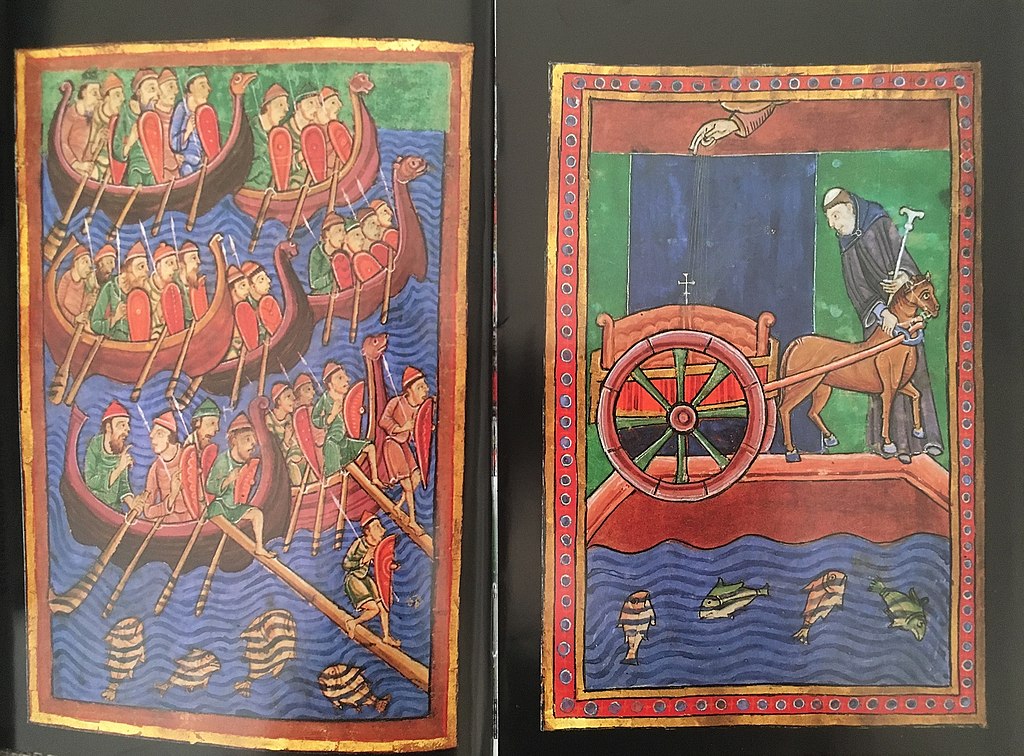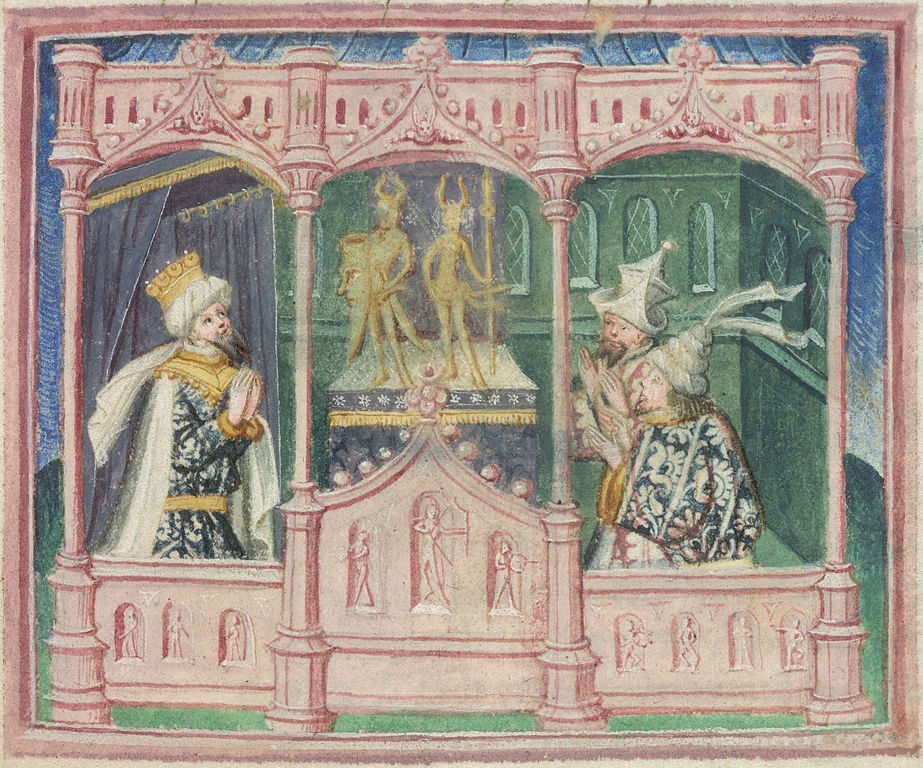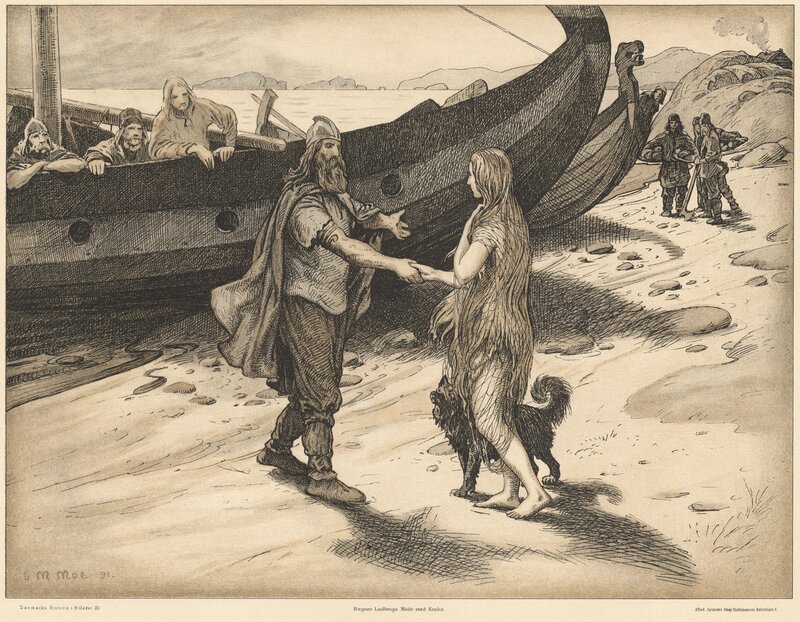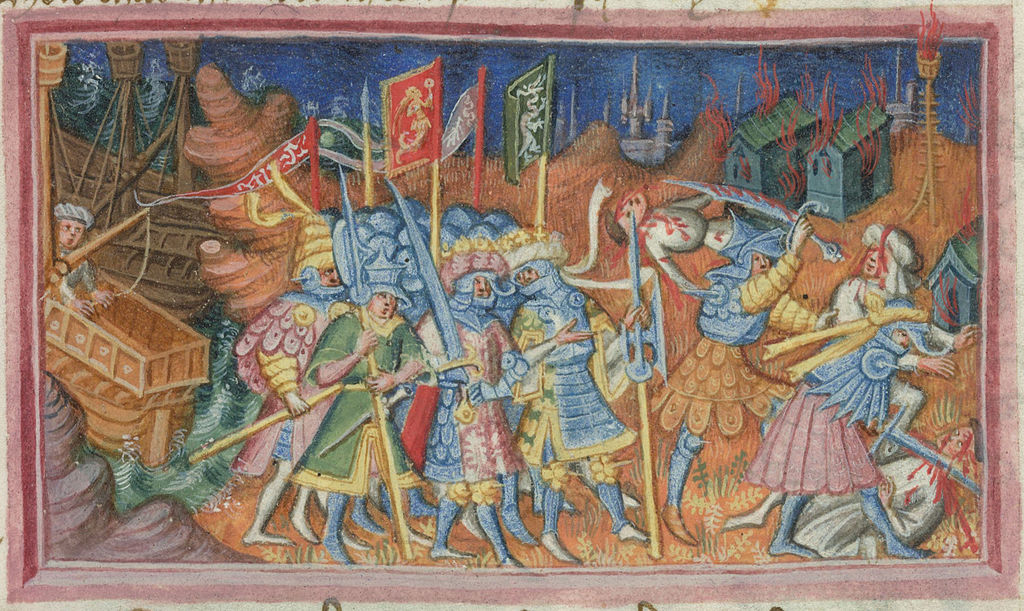According to texts in Old Norse and medieval Latin, Ivar the Boneless (or Ívarr Hinn Beinlausi in Old Norse) was the son of Ragnar Lothbrok, the legendary Viking king. Ivar was also known as Ivar Ragnarsson. In 865 AD, Ivar formed and became the chieftain of the Great Heathen Army, which invaded the Anglo-Saxon Heptarchy of the seven kingdoms of East Anglia, Essex, Kent, Mercia, Northumbria, Sussex, and Wessex.
Why Was Ivar The Boneless Famous?
He was famous for overcoming his disability and becoming the king of a foreign country thanks to his leadership and effective use of military strategy.
How Long Did Ivar The Boneless Live?
It isn’t easy to find accurate sources of Ivar’s birthdate, but englishhistory.net say it was 794 AD. However, that would make him 71 years old when he led a great army across to England in 865. His disability would almost certainly have meant he didn’t live much beyond 40, so his birthdate is more likely to have been closer to 830 AD.
Æthelweard, a writer of Anglo-Saxon chronicles, recorded his year of death as 870. However, The Fragmentary Annals of Ireland and The Annals of Ulster named it as 873. It is also uncertain if he died in Repton, England, or Dublin, Ireland.
What Did Ivar The Boneless Suffer From?
Legend has it that Ivar the Boneless was the victim of a hex laid upon his mother, Ragnar Lothbrok’s wife-to-be, Aslaug. Aslaug, a völva or sorceress, warned him that she had been cursed to give birth to a child with no bones if they didn’t wait three days before consummating their marriage. Ragnar ignored her request and left his wife with child on the wedding night.
Ivar was consequently born with a brittle bone condition which rendered him unable to walk.
The origin of his epithet is not clear. The translation of “Ívarr Beinlausi” could be “Ivar Boneless” or “Ivar Legless” as “bein” can mean “leg” or “bone.”
Unconfirmed theories exist of him having no legs, legs without bones, or suffering from osteogenesis imperfecta, a bone disorder also known as brittle bone disease.
A passage in the Old Norse tale Ragnarssona þáttr (or Tale of Ragnar’s Sons) suggests “Legless” was a way of saying Ivar was impotent.
You can learn more about Ivar The Boneless’ medical condition by reading this article on the Oxford University website.
What Did Ivar The Boneless Accomplish?
Ivar was reputed to have been an excellent battle strategist and planner and also an expert with a bow.
There are reports of him joining forces with Olaf the White, the son of a Norwegian king, in Ireland in 857. Together, they formed raiding parties and sacked various buildings, including monasteries. Ivar stayed there until 865, when he crossed the Irish Sea and ended up in Northumbria in northeast England.
He and his brothers, Halfdan and Hubba, invaded England to avenge his father’s death but were defeated by King Ælla of Northumbria’s large army. According to some accounts, his brothers fled back to Scandinavia (or Ireland). However, Ivar stayed and tricked Ælla by telling him he was not part of the invasion and demanding compensation for his father’s death.
Ælla told him he could have as much land as he covered a bull hide with. Again, fooling the king, he cut the hide into narrow strips and laid them over a large expanse of land. Once established, he captured the city of York and convinced his brothers to reassemble an army and return to England. He also recruited a large force of men, said to be around 15,000 strong, using local contacts he had made.

The Blood Eagle
He attacked Ælla and defeated him after pretending to stand down and lulling the Northumbrian king into a false sense of security. Ælla was later subjected to the horrible death known as “blood eagle.”
After installing the puppet ruler Egbert in Northumbria, Ivar went south to conquer Nottingham. The Mercian king Burgred asked the kingdom of Wessex for assistance. King Aethelred I and his brother, Alfred (who would be King Alfred the Great), arrived to help Nottingham and tip the battle in his favor, so Ivar and his force of Danes returned to York without a fight.
They regrouped and marched on Mercia again before proceeding further south and defeating King Edmund in East Anglia.
Ivar stayed in England until he died in 873. He had no children to continue his family name, maybe due to his affliction not allowing him to have intercourse, although records state it was “‘because of the way he was, with no lust or love.” (from The Saga of Ragnar Lothbrok).
Was Ivar The Boneless Cruel?
Ivar had a violent reputation, gained mainly for the savage way his armies fought. Tales paint him as a ruthless leader who encouraged his warriors to give no quarter in battle. He was a warlord whose Viking fighters cut a bloody swathe through Northern England.
Early Christian forces had never seen anything like the Berserker fury the Vikings fought with. Their habit of making blood sacrifices or blót shocked the English troops.
He was reputed to have used the blood eagle ritual when he had King Ælla of Northumbria executed.
How Did Ivar The Boneless Die?
Some reports state that he died of old age. However, Ímar’s (reputedly another name for Ivar) death appears in the Fragmentary Annals of Ireland. It is described as a “sudden and hideous disease.”
Although the translation mentions his name was “Gothfraid,“ this was “righ Lochlann” (“King of Lochlann” in the original version; “Lochlann” was Scandinavia or Norway) and almost certainly meant Ímar (or Ivar).
Ivar The Boneless Attestations
The Saga of Ivar Ragnarsson
The Saga of Ivar Ragnarsson says that Ivar was the eldest of three sons of Scandinavian king Ragnar Lodbrok and his third wife, Aslaug. Reports are confused as to whether Ragnar was from Sweden or Denmark.
The saga described Ivar as very tall, well-built, and strong. However, it also mentioned him as disabled and that his fellow Vikings carried him around on a shield.

The Tale of Ragnar Lodbrok
The Saga or Tale of Ragnar Lodbrok also names him as the son of Ragnar Lodbrok and his wife, Aslaug. His brothers were Björn Ironside, Hvitserk, Sigurd Snake-in-the-Eye, and Ubbe.
Scholars believe Ivar was the same person as Ímar, the Viking warrior who established the Uí Ímair dynasty in Ireland and Scotland in the 9th century.
Chapter seven says the following about Ivar:
the boy was boneless as if there were gristle where his bones should be. When he was young, he grew so large that no one was his equal. He was the most handsome of all men and so wise that it wasn’t certain whether there had ever been a wiser man than him.
Ivar the Boneless – Worldhistory Org
Aslaug and Sibilja
The tale also goes into more detail about Ivar’s mother, Aslaug. She was the daughter of legendary dragon slayer Sigurd and the Valkyrie Brynhild, who died when Aslaug was only three. It tells how a family raised her in Norway – they called her “Kráka” or “crow.”
Ivar is described as having extraordinary upper-body strength. While fighting King Eystein of Sweden, Ivar used a giant bow to shoot an arrow at Sibilja, Eystein’s magical cow, who was singlehandedly winning the battle for the king. The arrow hit the cow in the eye and drove it into a frenzy. Ivar’s men threw him at Sibilja, whom he crushed to death.
When he recovered, he bolstered his men with a piercing rallying cry that inspired them to victory.
In the final part of the saga, Ragnar invaded England, but King Ælla of Northumbria captured and killed him by having him cast into a snake pit.
The sons of Ragnar sailed to England to avenge their father, defeating Ælla and killing him by the ritual execution known as “blood eagle.” This execution involved making an incision in the back, removing the rib cage from the spinal column, and pulling the lungs through the dorsal wound to resemble wings.

Ragnarssona þáttr
We can infer from Ragnarssona þáttr or the Tales of Ragnar’s Sons that Ivar had male impotence.
Does Ivar The Boneless Appear In The History Channel Streaming Series Vikings?
Alex Høgh Andersen portrays Ivar The Boneless in the TV series Vikings. Other notable characters are Ragnar Lothbrok, his brother Rollo, and King Harald Finehair.
Ivar the Boneless also appears in the video game Assassin’s Creed Valhalla.

